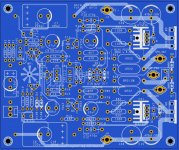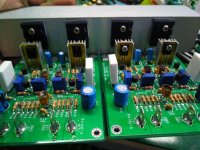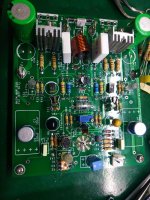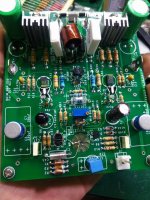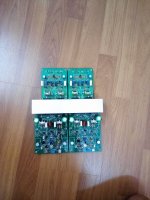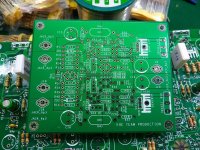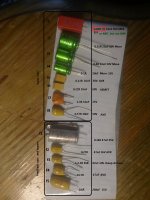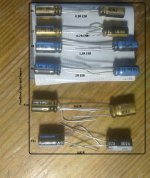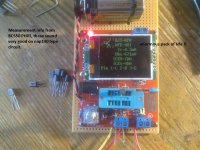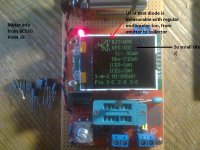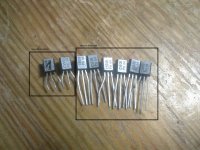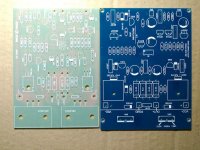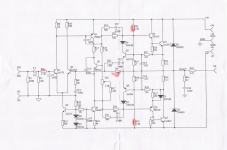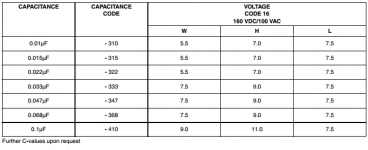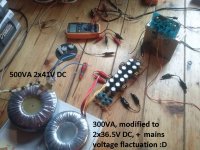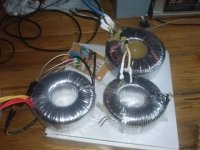If you read the sites where Chinese sellers advertise, you can see that they use a range of terms - often the wrong ones. Case and enclosure seem most common terms suiting solid state projects but chassis is (or rather, should be) a more appropriate term for just the metal support frame used with tube amps or sub-assemblies. Look for the common terms used on larger, popular sites with more products to sell. Then use those terms in phrases that appear to narrrow the focus to your interest..... I always go there to look for chassis. I don't know how to speak/write chinese so I write 'chassis' and 'aluminum' in Google translate but Taobao always shows everything else. Ha ha.
Can you help me with words to search for a chassis to build amps in Taobao?....
Of course, Chinese sellers don't understand the differences in the many terms used by English speakers in different countries. They may use any terms that get attention but many will be auto-translated from terms used in their own social media and forums. Some will become quite ridiculous in English and if that isn't your first language, there will be problems for sure.
I find that I have to try search words that would only be used by non-technical people who have no idea of the difference between technical terms either. When sellers call transistors "triodes" you begin to realise the serious communication problems out there. However, Google is good at interpretation and word association - it learns your interest from consistent use and will likely improve its own results over successive searches. Be patient and work at it
Hi
If anyone interesting about NAP 140 , i can provide PCB Power Amp and Regulator .
I layout PCB based on NAP 140 schematics and regulator ! Belows it's picture layout.
- Capacitor in based on Vishay axial tantanum cap
- NFB base on kemet tantan and pitch about 5mm for cap
- Layout for TO-3P Transistor like 2SC5200 or MJL3281A
- Pcb have modified option cap by pass power transistor.
Edit
You can chose 3 option
1. Full Kit : 2 pcb Amp + 2 pcb regulator - 30$ not include shipping ( EMS Shipping ).
2. PCB Power Amp only : 2 PCB Amp - 20$ not include shipping ( EMS Shipping ).
3. Regulator only : 2 PCB Regulator - 15$ not include shipping ( EMS Shipping ).
PCB: FR4 - 1.6mm
Copper : 2oz
Hot tin surface
Below it's some picture pcb i and my friend build !
If anyone interesting about NAP 140 , i can provide PCB Power Amp and Regulator .
I layout PCB based on NAP 140 schematics and regulator ! Belows it's picture layout.
- Capacitor in based on Vishay axial tantanum cap
- NFB base on kemet tantan and pitch about 5mm for cap
- Layout for TO-3P Transistor like 2SC5200 or MJL3281A
- Pcb have modified option cap by pass power transistor.
Edit
You can chose 3 option
1. Full Kit : 2 pcb Amp + 2 pcb regulator - 30$ not include shipping ( EMS Shipping ).
2. PCB Power Amp only : 2 PCB Amp - 20$ not include shipping ( EMS Shipping ).
3. Regulator only : 2 PCB Regulator - 15$ not include shipping ( EMS Shipping ).
PCB: FR4 - 1.6mm
Copper : 2oz
Hot tin surface
Below it's some picture pcb i and my friend build !
Attachments
Last edited:
If you read the sites where Chinese sellers advertise, you can see that they use a range of terms - often the wrong ones. Case and enclosure seem most common terms suiting solid state projects but chassis is (or rather, should be) a more appropriate term for just the metal support frame used with tube amps or sub-assemblies. Look for the common terms used on larger, popular sites with more products to sell. Then use those terms in phrases that appear to narrrow the focus to your interest.
Of course, Chinese sellers don't understand the differences in the many terms used by English speakers in different countries. They may use any terms that get attention but many will be auto-translated from terms used in their own social media and forums. Some will become quite ridiculous in English and if that isn't your first language, there will be problems for sure.
I find that I have to try search words that would only be used by non-technical people who have no idea of the difference between technical terms either. When sellers call transistors "triodes" you begin to realise the serious communication problems out there. However, Google is good at interpretation and word association - it learns your interest from consistent use and will likely improve its own results over successive searches. Be patient and work at it
I had this idea and got good results. I searched with the google translated phrase, and copy the labels of the listing phrase. Then in the listing itself there is a categories section at the bottom left of the product pages. Often they are labeled as "Aluminum cases" "Preamp cases" etc, so i used a mixture of those too. I'm glad now I got consistent good results!
The cheaper prices compared to ebay (Sometimes 1/5 of the prices) is very good.
10uF tantalum are usually less than 15V
100uF is probably somewhere around 5V.
Anything higher will be specials.
Correct yep and important.
For nap140 type circuit, different voltage rating on tantalums will impact the sound.
For example, lossy low voltage cheap chinese tants ~47-68uF with ~1.5R ESR will produce more foward sound with soft highs... very soft highs. While comparing amps, it only took few songs to understand how good highs my clone had. VAS needs to be from ZTX series.
I recently recieved another H-140 clone.
Measuring input BC550B PH04 transistors got me wondering...looks like an IGBT to me
What you guys think about BC550B PH04 transistors?
I would like to introduce snake oil capacitors a little,
here is what i have done:
I have listened to them all, long term, stereo config, NAP 140 close orig circuit and H-140 clone.
"i" stands for input capacitor
"f" is feedback and bypass
Input capacitors:
Good and all same-like capacitors, no difference.:
i8, i3, i1, i5
Interesting:
i7, i4
Metallic sound:
i6
Feedback and bypass:
Very interesting sound:
f3, f5, f6, f8, f9, tants have a huge impact on highs, making these softer.
here is what i have done:
I have listened to them all, long term, stereo config, NAP 140 close orig circuit and H-140 clone.
"i" stands for input capacitor
"f" is feedback and bypass
Input capacitors:
Good and all same-like capacitors, no difference.:
i8, i3, i1, i5
Interesting:
i7, i4
Metallic sound:
i6
Feedback and bypass:
Very interesting sound:
f3, f5, f6, f8, f9, tants have a huge impact on highs, making these softer.
Everything else is just normal, not very very bad and also not very good.
Using low ESR feedbacks and bypass is a bad idea in this circuit.
EDIT: TYPO: f4 is 68uF, not 47uF as marked.
Attachments
Last edited:
Naim used low value TAG tantalum caps (68uF) because larger types, which would have been better as the the feedback cap, were either too expensive, too low a voltage rating or just not available in the 1970s. When you take the option of using standard or NP electrolytic caps instead, you should also consider up-sizing them to 100-200 uF and using at least a 16V rating. The extra cost is minimal and there will be no risk of bass loss.
They chose capacitors carefully...not every tant or electro fits there.
I think a price is not an issue for a company.... considering the discounts they get when buying bulk of components.
More of an problem is selling, finding a client... marketing and so on.
Ian, the bass was never an issue...
Converting outputs to 2n3055 had HUGE impact on bass, removing 100R emitter resistors impact bass, BC546B or C change bass... but not the capacitors. Maybe its because 47uf-100uF is not so much of a difference...
This circuit calls for right tantalum capacitors and i dont know why
I think a price is not an issue for a company.... considering the discounts they get when buying bulk of components.
More of an problem is selling, finding a client... marketing and so on.
Ian, the bass was never an issue...
Converting outputs to 2n3055 had HUGE impact on bass, removing 100R emitter resistors impact bass, BC546B or C change bass... but not the capacitors. Maybe its because 47uf-100uF is not so much of a difference...
This circuit calls for right tantalum capacitors and i dont know why
Hi! My PCB is green.
Several questions about components.
1. С40 - Wima MKS-2 0,022 uF / 63V is good? MKP Wima is very big
2. Q1-Q2 I can't find BC239C. May be BC550 (Fairchild), BC546B (DC), BC546BG (ON Semiconductor)?
3. Q5 I can't find ztx384. BC546, BC550 or tip41C?
4. R21 560R or 620R?
5. R16 2,7K or 2,2K?
Several questions about components.
1. С40 - Wima MKS-2 0,022 uF / 63V is good? MKP Wima is very big
2. Q1-Q2 I can't find BC239C. May be BC550 (Fairchild), BC546B (DC), BC546BG (ON Semiconductor)?
3. Q5 I can't find ztx384. BC546, BC550 or tip41C?
4. R21 560R or 620R?
5. R16 2,7K or 2,2K?
Attachments
Hi,
C40, it depends again... 100-220nf, small wima is sufficient.
Q1-Q2, dont fail here, BC550B fairchild sufficient, BC550B PH03 philips best.
Q5, C2240 would be my option here, and not hard to get.
R21, it again depends...Try both and decide.
R16, 2.7K.
Also dont fail with DRIVERS, if you cant find original/correct TIP41C family, go with MJE243/253, or else amp will not sound.
Most important that i found lately is the rail voltage that you will feed to your amp.
I found myself, that NOTHING is better then +/- 36V or absolute Maximum: 37V, in your case without the front end RC network, 33 or 34V would sound the best.
All others here and myself who used the amps with 40+ rail voltage failed hard. Its important... if you miss it... you will end up tuning your amp forever(changing every possible component and have a moment with a new FAIL sound thinking its cool..... it lasts a day... and after you will hate it).
C40, it depends again... 100-220nf, small wima is sufficient.
Q1-Q2, dont fail here, BC550B fairchild sufficient, BC550B PH03 philips best.
Q5, C2240 would be my option here, and not hard to get.
R21, it again depends...Try both and decide.
R16, 2.7K.
Also dont fail with DRIVERS, if you cant find original/correct TIP41C family, go with MJE243/253, or else amp will not sound.
Most important that i found lately is the rail voltage that you will feed to your amp.
I found myself, that NOTHING is better then +/- 36V or absolute Maximum: 37V, in your case without the front end RC network, 33 or 34V would sound the best.
All others here and myself who used the amps with 40+ rail voltage failed hard. Its important... if you miss it... you will end up tuning your amp forever(changing every possible component and have a moment with a new FAIL sound thinking its cool..... it lasts a day... and after you will hate it).
Last edited:
And, if you happen to have output transistors with different HFE, then try to place LOWER HFE one in place of Q12, Higher HFE to Q11 position. This approach will "soften" the sound on MID-HIGH-s.
Also, Filterbank PSU must be in right size for correct operation, exceeding 15mF per rail will give you better background sound, but worse "overall" sound.
Using regular low-esr electrolytics in place of C6 and C5 will result in the same effect as with 15mF+ filter PSU
EDIT: there is no need for exotic nano tech snakeoil components for audio, just correct approach and bias, circuit will sound good with ceramics all over it
Failing it doing with regular components, snake oil will not help here either... it will make you think it helped... for a moment again )
)
Also, Filterbank PSU must be in right size for correct operation, exceeding 15mF per rail will give you better background sound, but worse "overall" sound.
Using regular low-esr electrolytics in place of C6 and C5 will result in the same effect as with 15mF+ filter PSU
EDIT: there is no need for exotic nano tech snakeoil components for audio, just correct approach and bias, circuit will sound good with ceramics all over it
Failing it doing with regular components, snake oil will not help here either... it will make you think it helped... for a moment again
Last edited:
Hi Alex. There are are many categories of film caps and DIY people often substitute to either get cheap prices or smaller size. However, polyester film types like MKT, MKS or MMK are generally not the best for audio applications. https://en.wikipedia.org/wiki/Film_capacitorHi! My PCB is green.
Several questions about components.
1. С40 - Wima MKS-2 0,022 uF / 63V is good? MKP Wima is very big....
However, MKT type is OK and commonly used for the Zobel network (the RC shunt to ground at the output) capacitor of 220nF or 0.22 uF, as in Naim NAP models and most class AB amplifers. I think this must be the cap you mean (C40?). There is no claimed benefit to substituting polypropylene types in that Zobel network though.
MKP type is certainly larger than MKS but 0.022uF is not a large value cap in either type. Attached is Vishay Roederstein's dimensional spec. for 160V rated MKP caps:
As a general comment, I now find it is a good idea and usually cheaper to buy a full kit of Ebay PCB + components. In good quality kits like those for the PCBs you have, the few parts that could be upgraded (if you believe they will be better) won't be important to getting it working well and at least they will fit the PCB without hassles.
Attachments
Last edited:
Ian comment MMK are generally not the best for audio applications having just taking my mmk out of the feed back and vbe replaced with tants feed back and oscon vbe and ran room eq (emotive emoq room correction) this has 11 band eq and now are very flat not more than 2db 30 hz to 11khz in the past i had with mmk 7db boost 30> 80hz and 5khz and up had boost as well 3>6db note the cat in the past 0> 150 mph to get out of the room now no the caps did need a bit of runing to to warm up and now sounds so much better now
Ian comment MMK are generally not the best for audio applications having just taking my mmk out of the feed back and vbe replaced with tants feed back and oscon vbe and ran room eq (emotive emoq room correction) this has 11 band eq and now are very flat not more than 2db 30 hz to 11khz in the past i had with mmk 7db boost 30> 80hz and 5khz and up had boost as well 3>6db note the cat in the past 0> 150 mph to get out of the room now no the caps did need a bit of runing to to warm up and now sounds so much better now
What circuit, what voltage, filterbank and so on ?
Ian and Alex were discussing the output zobel network cap value, even a ceramic does very well in there, if one keeps the amplifier case temp. low, so that ceramics wont be affected from it.
Naim used HI-end FILTER caps cuz of the heat that was generated in the case.
Attachments
AndrewT has rightly pointed out several times that the capacitor which should determine the lower frequency roll-off is the input cap, not the feedback cap, because feedback needs to have the widest bandwidth possible, in order to be uniformly effective across the audio range. This is not the only reason, nor is so much about subjective sound quality but it is about better bass linearity, less LF distortion.They chose capacitors carefully...not every tant or electro fits there....I think a price is not an issue for a company.... considering the discounts they get when buying bulk of components.
More of an problem is selling, finding a client... marketing and so on.
Ian, the bass was never an issue...
Converting outputs to 2n3055 had HUGE impact on bass, removing 100R emitter resistors impact bass, BC546B or C change bass... but not the capacitors. Maybe its because 47uf-100uF is not so much of a difference...
This circuit calls for right tantalum capacitors and i dont know why
There are a number of NAP sound effects that definitely depend on using original spec. parts and generally, I agree that the tantalum caps should stay but I have come to realise that the FB cap is an exception.
Last edited:
Rensli not sure what make it is the one that came with the kit it is marked u1j63 it a good chance its Polyester.
h140 clone from hifidly net aeon copy nap140 2007
voltage +- 37v depends on time of day can be up to 39 or down to 36
filterbank 4 x Nover LA 10000uf 50v 20000uf per rail and 100nf evox mmk per rail
this amp H-140 Audio Power Amplifier Kit 80W+80W clone NIAM NAP140 DIY | eBay
h140 clone from hifidly net aeon copy nap140 2007
voltage +- 37v depends on time of day can be up to 39 or down to 36
filterbank 4 x Nover LA 10000uf 50v 20000uf per rail and 100nf evox mmk per rail
this amp H-140 Audio Power Amplifier Kit 80W+80W clone NIAM NAP140 DIY | eBay
The FB cap is 47 or 68uF in NAP models. You need to use an electrolytic or tantalum type there because other types are not practical at those values.Ian the fb cap having a number in this position eltro, BP, mmk, oscons, i keep coming back to taints, it easy for me to make the change as when first made the mmk need to be on flying leads and to make life easy plugs and sockets
As a general rule, don't connect components to the PCB on leads with or without connectors etc because this invites noise, RFI and stray reactances, instability etc. If the parts you want to use don't fit on your PCB, trying to adapt them with long leads will almost certainly spoil any alleged benefit. That alone would make the parts choice a bad one.
The H140 clone kit builds into a simplified version of the Naim design, not really suitable for building a clone. If you want a clone, the boards used by Alex74 will be closer while still being inexpensive.
gents some of the caps i have tested
[10 pcs] 68uF/25V CTS13 Axial Tantalum Capacitors Vishay-Sprague | eBay
60x K53-4 ( 10uF 30% , 20V ) Axial Tantalum Capacitors Military Grade BOX USSR | eBay
50x K53-4 ( 68uF 20% , 15V ) Axial Tantalum Capacitors Military Grade BOX USSR | eBay
What a chicken, you really dont need so hi-end caps here...
Regular tantalum with a some internal ESR/impedance will do the job just fine lol
Ian Finch,
Yes, i have also compared it myself... distortion on LF increases when for example, 47uf 6.3V high impedance electro is used at feedback
I need just a little more time to come up with most FLAT results... ofcourse... there is naim effects involved too but they are flat also and easy listen.
All i do is comparing clone to another "linear" commercial amplifier(STK based). Its easy and not confusing. Most important is to use "same volume" settings.
Last edited:
- Home
- Amplifiers
- Solid State
- NAP-140 Clone Amp Kit on eBay
